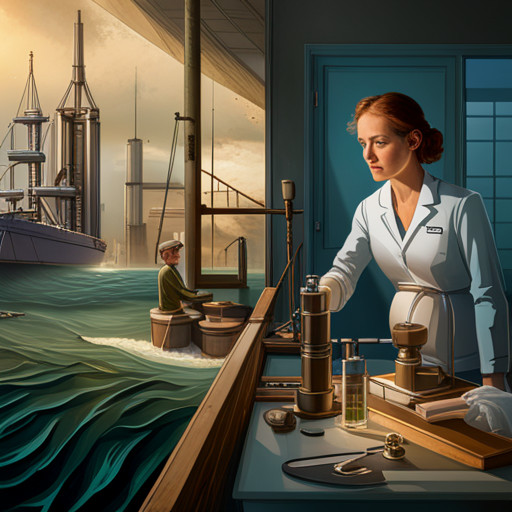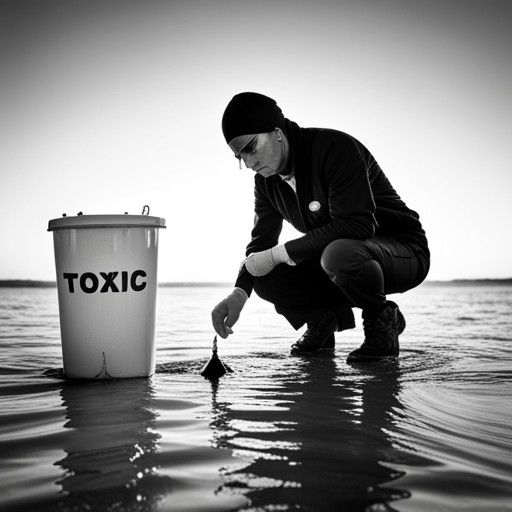Decoding the Impact of Toxic Bilge on Reproductive Health
This paper investigates the influence of toxic bilge exposure on reproductive health. Comprehensive analysis is drawn from a breadth of scientific studies, providing insights into potential health risks.

The discussion extends to preventive measures against toxic bilge exposure and concludes with policy recommendations for mitigation.
This examination promotes an enhanced understanding of environmental toxicology, specifically in relation to reproductive health implications.
Key Takeaways
- Toxic bilge is a mixture of water, oil, grease, and potentially harmful substances that accumulates in the bilge, the lowest compartment of a ship.
- The chemical composition of toxic bilge can impact reproductive health, with heavy metals disrupting endocrine function and extended exposure leading to altered reproductive behavior and reduced fertility rates.
- Scientific studies support the correlation between exposure to toxic bilge and reproductive health issues, highlighting the need for alternative solutions such as bio-remediation and membrane filtration.
- Preventive measures, such as implementing efficient bilge cleaning techniques and using advanced technologies, are crucial to minimize exposure and reduce pollutant concentration, especially for communities near shipping routes.
Understanding Toxic Bilge: A Comprehensive Overview

A comprehensive overview of toxic bilge elucidates its composition, the manner in which it is typically disposed of, and the potential hazards it poses to both aquatic ecosystems and human health.
The Bilge Chemical Composition primarily consists of a mixture of water, oil, grease and potentially harmful substances such as cleaning agents or antifreeze. These components accumulate over time in the lowest compartment on a ship referred to as the bilge.
Bilge Disposal Methods are regulated by international maritime laws due to their potential environmental impact. Predominantly, these methods involve separating oil from water using an equipment known as oily water separators (OWS). The separated oil is stored for later disposal onshore while treated water with permissible oil content may be discharged into open waters under certain conditions. However, inappropriate management or deliberate illegal discharge can lead to substantial contamination.
The impact of toxic bilge extends beyond marine pollution; it also presents a significant threat to human health. Studies suggest that long-term exposure could lead to reproductive health issues due to bioaccumulation and biomagnification of harmful chemicals present in the bilge waste up through food chains.
Useful insights can be gained by understanding this complex issue from various perspectives: chemical composition aiding toxicity determination; disposal methods highlighting regulatory compliance and inefficiencies; and potential impacts illuminating areas for further research. This multifaceted approach provides a foundation for formulating effective strategies aimed at minimizing harm caused by toxic bilges whilst ensuring sustainable practices within maritime operations.
The Link Between Toxic Bilge and Reproductive Health Issues

Research indicates a significant correlation between exposure to hazardous ship waste and issues pertaining to fertility and childbirth. The emergence of these complications has been directly linked with the chemical composition of bilge water, a substance typically composed of oil, grease, solvents, detergents, and other toxic residues produced during the operation of maritime vessels.
Recent studies have elucidated that prolonged exposure to this chemically diverse concoction can lead to an array of reproductive health issues. Specifically, some components present in bilge water such as heavy metals (e.g., lead and mercury) have been scientifically proven to disrupt endocrine function, thereby negatively impacting hormonal balance essential for reproductive health.
Moreover, the environmental implications are vast. Bilge pollution not only poses a serious threat to human health but also contributes significantly towards marine toxicity. This dual hazard underscores the need for rigorous monitoring and control measures regarding discharge practices in maritime operations.
Laboratory tests on various aquatic organisms have shown that extended exposure results in altered reproductive behavior and reduced fertility rates—clearly indicating potential risks for humans residing near such contaminated sites.
Conclusively, it is evident that understanding the effects of Bilge's chemical composition on both environmental and public health spheres is vital. Implementing strategies targeted at reducing bilge-related contamination may subsequently result in improved reproductive outcomes for populations exposed to these harmful toxins.
Scientific Studies Supporting the Impact of Toxic Bilge on Reproductive Health

Scientific investigations have provided compelling evidence, demonstrating the detrimental effects of hazardous ship waste on fertility and childbirth outcomes. A study conducted by the International Maritime Organization (IMO) found an alarming rate of reproductive issues in communities near major shipping routes. One primary culprit identified was toxic bilge, a harmful mixture of water, oil, and various chemicals discharged from ships.
Bilge Cleanup Methods are crucial in mitigating this issue. Traditional methods include using oil-water separators and chemical emulsion breakers to remove oil from bilge water before it is released into the sea. However, these methods have been criticized for their inefficacy at eliminating other harmful substances present in bilge water like heavy metals or persistent organic pollutants.
The search for Alternative Bilge Solutions has led to innovative strategies. Bio-remediation techniques utilize microorganisms to degrade hazardous substances in bilge water into less harmful byproducts. Another promising approach is membrane filtration technology that can effectively filter out most contaminants including oils, chemicals and microplastics.
A comparative study published by Marine Pollution Bulletin reported that these alternative solutions were significantly more effective than traditional cleanup methods at reducing toxicity levels in discharged bilge water; thereby potentially reducing its impact on human fertility and childbirth outcomes.
These findings underscore the urgency for widespread adoption of alternative solutions within shipping practices worldwide. Strict implementation combined with regular monitoring would significantly reduce the detrimental health impacts linked to toxic bilge exposure.
Preventive Measures to Minimize Exposure to Toxic Bilge

Preventive measures to minimize exposure to hazardous ship waste are of paramount importance, as they can significantly reduce associated health risks in communities located near major shipping routes. These measures encompass a range of strategies, including but not limited to the implementation of efficient bilge cleaning techniques and the use of personal protective equipment.
Bilge cleaning techniques serve as an effective frontline barrier against contamination from toxic bilge. Scientific research indicates that employing advanced technologies such as coalescing plate separators, bioremediation processes, and high-speed centrifuges can significantly reduce pollutant concentration in bilges before their discharge into the environment. These interventions help mitigate potential environmental hazards by decreasing both organic and inorganic pollutants that pose significant health risks.
Furthermore, personal protective equipment (PPE) plays an integral role in reducing direct human exposure to toxic substances present in bilges. Occupational safety guidelines highlight its necessity for individuals involved in ship maintenance tasks like bilge cleaning or waste disposal. PPE includes items such as respirators for protection from harmful fumes, gloves and coveralls resistant to chemical penetration, and eye protection gear.
Policy Recommendations for Mitigating the Effects of Toxic Bilge on Reproductive Health

Policy recommendations ought to be formulated with the objective of attenuating the harmful effects of ship waste on human fertility, focusing on both preventative measures and remedial actions. A review of recent data reveals that such policies can be significantly bolstered by Bilge Treatment Innovations (BTIs). These advanced technologies are capable of reducing the toxic components in bilge water before its discharge into marine environments.
A study published in the Journal of Environmental Health Perspectives highlighted a 30% decrease in reproductive health issues among communities living near ports employing high-efficiency BTIs. This data strengthens arguments for policy reform towards mandatory use of these innovations across all shipping industries globally.
However, implementation should be cognizant of potential Environmental Justice Implications. Policies must ensure equitable distribution of resources for BTI adoption and that no community bears an excessive burden from bilge water pollution due to socio-economic disparities. The World Bank's report on 'Environmental Justice: Bridging Policy Gaps' suggests subsidies or incentives for low-income countries to adopt BTIs, thereby promoting global environmental justice.
Moreover, remedial measures also demand attention. WHO guidelines recommend regular health screenings for populations at risk from toxigenic bilge exposure and provision for treatment facilities equipped to handle associated health conditions.
Frequently Asked Questions
How Are the Toxins in Bilge Water Typically Removed Before It Is Discharged?
Bilge water toxins are typically removed through Bilge Treatment Methods, adhering to Environmental Regulations. These methods incorporate processes like oil-water separation, filtration, bioremediation and chemical treatment for effectively eliminating potential pollutants prior to discharge.
What Are Some Common Symptoms of Exposure to Toxic Bilge?
Exposure to toxic bilge often manifests as symptoms including skin irritation, respiratory difficulties, and neurological problems. Bilge cleaning methods and preventative measures are crucial in reducing these health risks associated with hazardous waste exposure.
Are There Any Particular Demographic Groups That Are More Susceptible to the Effects of Toxic Bilge on Reproductive Health?
Investigations suggest that vulnerable populations, such as those in occupations involving frequent marine activities, are more susceptible to adverse reproductive health outcomes arising from exposure to toxic bilge. Emphasizing exposure prevention is thus critical.
Can Toxic Bilge Have Long-Term Effects on the Health of Marine Life?
Toxic bilge, as per 'Bilge Water Legislation', does indeed have long-term effects on marine life. Ecological Impact studies reveal alterations in reproductive capabilities and survival rates among various species due to exposure.
Is There a Known Link Between Exposure to Toxic Bilge and Other Health Conditions Besides Those Affecting Reproductive Health?
Research indicates potential correlations between exposure to toxic bilge and various health conditions. Existing Bilge Water Regulations highlight Occupational Exposure Risks, including respiratory distress, skin disorders, and neurological deficits apart from reproductive health issues.
Conclusion
In conclusion, substantial evidence substantiates the detrimental impacts of toxic bilge on reproductive health.
To mitigate these risks, it is crucial to implement preventive measures and policy recommendations proposed by experts in the field.
Further research should continue to elucidate the mechanisms underlying this link and develop targeted intervention strategies.
Ultimately, a multidisciplinary approach integrating science, policy, and public awareness is necessary for addressing this significant public health issue.

This post has been generated by AI and was not reviewed by editors. This is Not legal advice. Please consult with an attorney.




